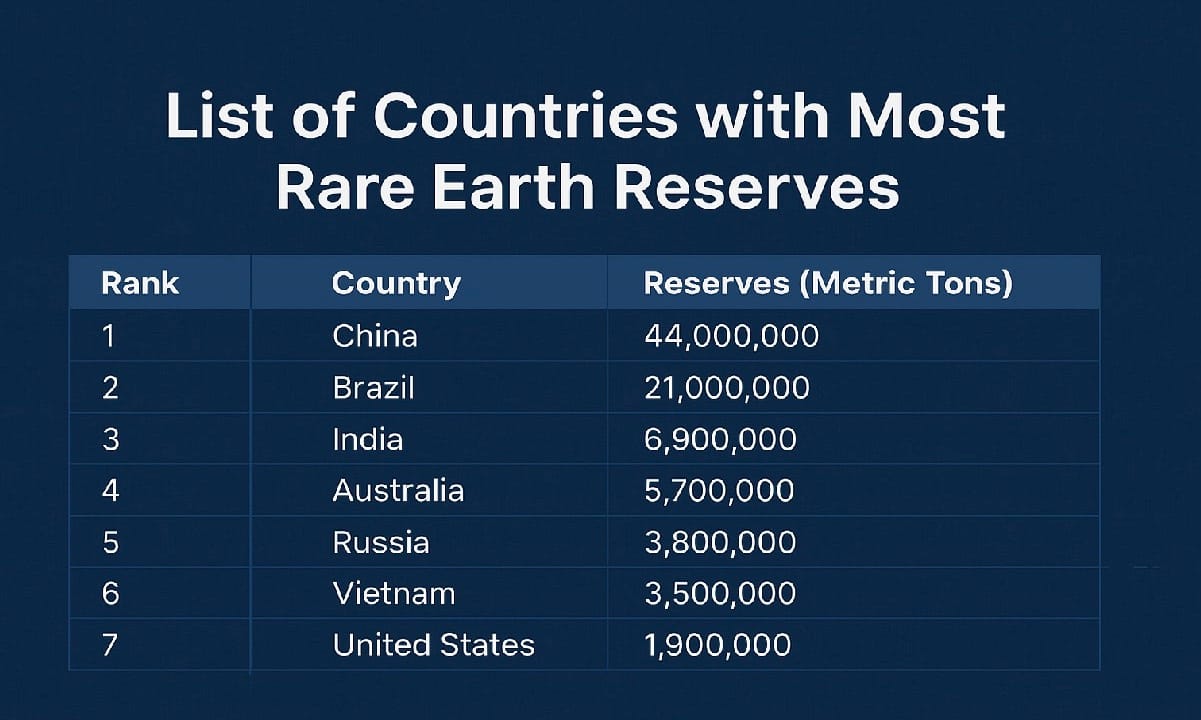Highlights of Global Rare Earth Reserves
Table of Contents
show
| Rank | Country | Reserves (Metric Tons) | Key Minerals | Major Deposit Type |
|---|---|---|---|---|
| 1 | China | 44,000,000 | Cerium, Lanthanum, Neodymium, Dysprosium, Yttrium | Bastnäsite & Ion-Adsorption Clays |
| 2 | Brazil | 21,000,000 | Neodymium, Praseodymium, Dysprosium, Terbium | Ionic Clay Deposits |
| 3 | India | 6,900,000 | Cerium, Lanthanum, Neodymium, Samarium, Yttrium | Monazite Sands (Coastal) |
| 4 | Australia | 5,700,000 | Cerium, Neodymium, Lanthanum | Bastnäsite & Monazite (Hard Rock) |
| 5 | Russia | 3,800,000 | Lanthanum, Cerium, Neodymium | Loparite & Apatite Rocks |
| 6 | Vietnam | 3,500,000 | Neodymium, Dysprosium, Terbium | Northwest Region Deposits |
| 7 | United States | 1,900,000 | Neodymium, Cerium, Praseodymium | Mountain Pass Mine |
1. China: The Global Leader
China is by far the largest holder of rare earth reserves, with about 44 million metric tons. This represents nearly half of global reserves. Apart from mining, China also dominates the processing and refining stages, controlling more than 90% of global capacity.The government maintains strict production quotas, giving China significant control over international prices and supply. Rare earths from China are vital for industries ranging from electronics to defence equipment worldwide.2. Brazil: Untapped Potential
Brazil comes second with 21 million metric tons of rare earth reserves. However, its production remains very small compared to its potential. Most of Brazil’s deposits are in ionic clays, similar to those in China.If fully developed, Brazil could become a strong alternative supplier, reducing global dependence on China. Many international projects are being planned to unlock this huge potential.3. India: Rich in Coastal Monazite Sands
India has about 6.9 million metric tons of rare earth reserves, mostly located in monazite sands along the coasts. These sands are rich in elements like cerium, neodymium, samarium, and yttrium.Despite its reserves, India currently produces less than 1% of the global output. To change this, the government has launched the National Critical Mineral Mission (2025) to boost mining and processing. If successful, India could become a major global player.4. Australia: Reliable Supplier
Australia holds 5.7 million metric tons of reserves and is already one of the largest producers outside China. The Mount Weld mine in Western Australia is one of the world’s richest rare earth deposits.Australia is actively working with allies like the United States and Japan to create a more secure and diversified rare earth supply chain. Its political stability makes it a trusted supplier.5. Russia: Large but Restricted
Russia has around 3.8 million metric tons of reserves, mainly in loparite and apatite rocks. Its production is controlled by state-owned firms and is focused largely on domestic industries.Due to geopolitical tensions, Russia’s role in the global rare earth market remains limited. However, its reserves still make it an important player in the long run.6. Vietnam: Rising Contributor
Vietnam holds about 3.5 million metric tons of rare earth reserves, mostly in the Northwest region. Although its numbers were revised down from earlier estimates, the country has big plans.Vietnam is actively seeking foreign investment and modern technology to expand production by 2030. If successful, it could join the group of top suppliers.7. United States: Growing Domestic Production
The US has 1.9 million metric tons of reserves. Most of its production comes from the Mountain Pass mine in California. However, despite having resources, the US remains heavily dependent on China for refined rare earth materials.Ensuring an independent supply chain is now a national security priority for the US, especially for defence and high-tech industries.Why Rare Earths Matter
Rare earths are used in:- Permanent magnets (for electric vehicles, wind turbines, and electronics)
- Lasers and fibre optics
- Rechargeable batteries
- Catalytic converters in vehicles
- Military equipment such as radars and guidance systems

